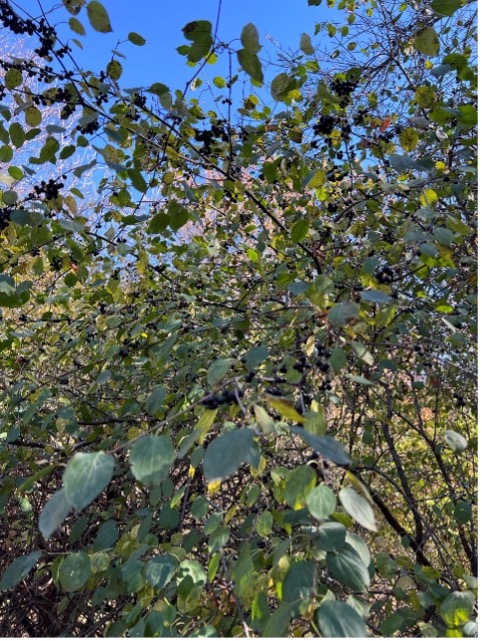This invasive plant has been around for quite some time. This plant was brought here from Eastern Europe and was used as a hedge and for landscaping. There was a well-maintained hedge of this shrub on West Fourth Street in Spencer for years that had even been trimmed over top of a sidewalk creating a unique entry to a home. I’m sure you have seen European Buckthorn invading area woodlands and mature farm windbreaks. This time of the year it is easy to spot as the foliage is still green while surrounding plants have mostly lost their foliage.
European Buckthorn grows ten to twenty-five feet tall with glossy leaves that are arranged opposite from each other on a twig, but occasionally alternate from each other on a twig. Small white flowers in the spring produce fruits called a Sloe which is edible and a favorite of songbirds. A relative of Plum trees, the bark of this plant has lenticels (corky areas of growth that are slightly raised above the bark). Fruiting Cherry and Plum trees also have bark that bears lenticels. The name Buckthorn indicates that this plant has thorns, and it does! Previous seasons growth often ends in a thorn which is also an identifying trait of this shrub.

These photos were taken near Gull Point State Park in Dickinson County. But this invasive shrub is found in Okoboji, Storm Lake, Sheldon, Sioux Falls and elsewhere. Small shrubs can be easily dug up with a shovel. Larger plants can be cut off at the ground and then painted with Fertilome Brush and Stump Killer found at Del’s Garden Center, Spencer. Applications of Fertilome Killzall and other foliar herbicides are effective in controlling this invasive shrub. I’ve also suggested the use of goats to control this shrub in woodlots and farm windbreaks. Buckthorn is often found growing with other invasive shrubs and trees including Mulberry, Elderberry, Black Raspberry and Honeysuckle. Goats do a nice job of cleaning up all but the largest of these shrubs and trees. See the link below for “Goats on the Go”.
There is one other option that I suggest as a control method. This control method does not kill the existing Buckthorn but reduces the amount of fruit available to songbirds. The name of the fruit is a Sloe. Soak Buckthorn Sloes with Gin and sweeten the solution with some sugar to produce your own Sloe Gin. Yes! You heard it here first.
If you have the need to replace Green Ash trees killed by Emerald Ash Borer or evergreen trees that have dried from drought or Pine Wilt Disease; Del’s Garden Center is here to help! Let the horticultural experts at Del’s suggest majestic Maples and stately Oaks mixed with native trees like Hackberry, Kentucky Coffee Tree, and Ohio Buckeye. We are preaching diversity, diversity, diversity to avoid the next invasive pest that could damage trees and evergreens in Iowa.
For more information about invasive Buckthorn, see the links below!
– Todd Brockshus, Sr Horticulturalist
https://naturalresources.extension.iastate.edu/encyclopedia/buckthorn-invasive-species-profile
